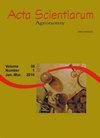Banana leaf anatomy characteristics related to ploidy levels
IF 1.2
4区 农林科学
Q3 AGRONOMY
引用次数: 2
Abstract
Many important crops have cultivars with different ploidy and provide a diverse choice of materials for breeding programs. Therefore, it is essential to accurately assess the ploidy of all breeding materials. Increased DNA content is known to have various effects on external and internal morphology, an effect known as the “nucleotypic effect”. Thus, anatomical assessment can be used as a tool for determining ploidy in plants, making the chromosome counting technique or flow cytometry unnecessary. This study aimed to evaluate the leaf anatomical characteristics of banana cultivars and understand the relationship between these features and ploidy levels. Thirteen accessions were evaluated, including diploid, triploid, and tetraploid genotypes, and cultivars, resulting from in vitro propagation after 90 days of acclimatization. Five fully expanded young leaves were collected from each cultivar, fixed in FAA70 (formaldehyde–acetic acid–ethanol) and preserved in 70% alcohol. Transverse and paradermal sections of the abaxial and adaxial regions were taken, and variables such as size and stomatal density, leaf thickness in the midrib and fourth vascular bundle region, and thickness of the epidermis, hypodermis, and parenchyma were measured. Results for leaf thickness, stomatal size, and density proved to be appropriate parameters for characterizing banana ploidy levels.香蕉叶解剖特征与倍性水平的关系
许多重要作物都有不同倍性的品种,为育种计划提供了多样化的材料选择。因此,准确评估所有育种材料的倍性至关重要。已知增加的DNA含量对外部和内部形态有各种影响,这种影响被称为“核型效应”。因此,解剖评估可以作为确定植物倍性的工具,使染色体计数技术或流式细胞术变得不必要。本研究旨在评价香蕉品种叶片解剖特征及其与倍性水平的关系。本研究评估了13份材料,包括二倍体、三倍体和四倍体基因型,以及经过90天驯化后体外繁殖的品种。每个品种采集5片完全展开的幼叶,用FAA70(甲醛-乙酸-乙醇)固定,70%酒精保存。取其背面和正面的横切面和纵切面,测量其大小和气孔密度、中脉和第四维管束区叶片厚度、表皮、下皮层和薄壁组织厚度等参数。结果表明,叶片厚度、气孔大小和密度是表征香蕉倍性水平的适宜参数。
本文章由计算机程序翻译,如有差异,请以英文原文为准。
求助全文
约1分钟内获得全文
求助全文
来源期刊

Acta Scientiarum. Agronomy.
Agricultural and Biological Sciences-Agronomy and Crop Science
CiteScore
2.40
自引率
0.00%
发文量
45
审稿时长
>12 weeks
期刊介绍:
The journal publishes original articles in all areas of Agronomy, including soil sciences, agricultural entomology, soil fertility and manuring, soil physics, physiology of cultivated plants, phytopathology, phyto-health, phytotechny, genesis, morphology and soil classification, management and conservation of soil, integrated management of plant pests, vegetal improvement, agricultural microbiology, agricultural parasitology, production and processing of seeds.
 求助内容:
求助内容: 应助结果提醒方式:
应助结果提醒方式:


